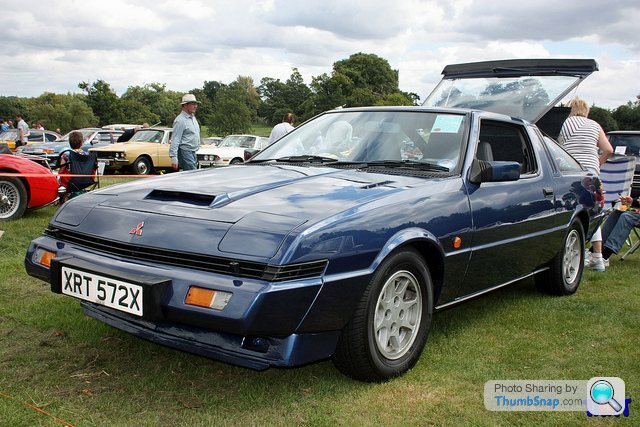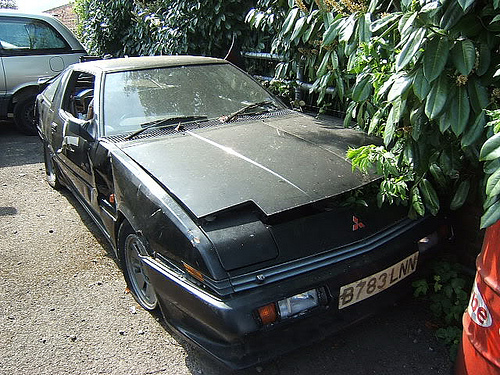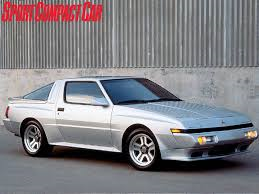starion buyers guide
Discussion
Hi,
There were a few different models of starion, slim body from approx 81 to 85 then wide body from approx 87 to 91.
Engines varied across the range as follows, (to the best of my knowledge), All starions up until '87 had the 4G63B 2.0 turbo engine in them, early ones were non intercooler the same as engine in the galants / sapporos / lancer turbos of the time ( see my profile for a lancer).
It put out about 160 bhp at the time and were easily tuneable to over 200 .

The second engine option on the starion was the 2.0 intercooler option which appeared late 85 and ran on all the slim bodies and a few early wide bodies up until 1987 - these were distinguishable by the fact the bonnet had no "scoop" on it. They had a different injection system iirc and like the 4G before it had no real problems as long as the were regular oil changes and they were allowed to cool down properly, as the IHI turbo unit was not water cooled.
All 4G63 Engines had "counter rotating balancer shafts" which smoothed out the engine, giving it the smoothness of a V8 allegedly, the belts on these need regular inspection and replacing, because if one snaps, it w kers the balance of the engine and can lead to big problems. You'll know when one has gone because it will sound like a big end going.
kers the balance of the engine and can lead to big problems. You'll know when one has gone because it will sound like a big end going.
Also, avoid detonation when running increased boost, or if you're considering a chipped one, standard pistons can handle about 18 psi, but one ounce of "det" and they'll crack. Alternatives are 2.0 Zetec pistons and machining the little end and Con Rod to take the gudgeon pin, or a set of (very muchly) expensive Omegas.
(I know its bashed up, but the only pic I could find )
)

The last and final option of starion engines were the 2.6 on the wide body. They ran on unleaded, unlike the others yet produced less power. It's essentially the same block as the pajero / shogun 2.6 petrol and are reliable, but also tuneable to over 400 hp in the right hands.

Early slim body stations suffered from rust on the rear arches, sticky calipers, rear suspension issues with the early set up and uneven tyre wear caused by the power steering .Doors can suffer with drop, rust around the bonnet, door bottoms, and front chassis can be troublesome.
Electrics are usually bulletproof, gearboxes excellent and the LSD and drivetrain very good. Clutches good for 70k easy. The engines suffer badly if they have had poor maintenance. I've seen some horribly carbon baked IHI units and clogged galleries , mucky heads due to poor oil choice and servicing.
we often changed the standard IHI unit for a Garett T-3 using an adaptor plate and a later thermostat housing from a Starion Wide body, on which the turbo's were water cooled. One thing to remember is to drill out the Oil gallery feed nut to 4mm, otherwise you'll starve the Garett turbo bearings of oil (cost me a few turbo's to find this out).
The ECI injection system on the 2.0's is not direct to port, but 2 injectors feeding one plenum chamber. As long as they remain sealed and you don't muck about with them, they remain trouble free, but keep an eye on the rubber pipes around it as they tend to perish and then knock the whole car out of sync. The engine is run by an early ECU, chips are easy to find. You can then run higher boost pressures and have an easy extra 40 hp on tap for a chip change and putting more preload on the actuator arm, that's before intercooling, turning the ECI, fuel pump change and there's even an option to add forged pistons and carillo rods.
The ECU also has a clever trick of automatically adjusting the mixture according to the altitude. Hmmm.
running problems can usually be attributed to an air leak. The engines are sensitive to air leaks, split hoses or incorrect mixtures.
Later starions , specifically wide bodies suffer with bad rust around the rear arches, and they're a b h to put right. Parts are usually more expensive on the wides bodies as nothing is really interchangeable with any other model, they have different calipers, 5 stud axles and totally different electrical systems, which are again, pretty good. I'm not too clued up on wide bodies, but the starion owners club will certainly put you right.
h to put right. Parts are usually more expensive on the wides bodies as nothing is really interchangeable with any other model, they have different calipers, 5 stud axles and totally different electrical systems, which are again, pretty good. I'm not too clued up on wide bodies, but the starion owners club will certainly put you right.
IIRC Wide bodies did suffer from head gasket failures after being chipped, not sure why this was though.
The best Starion to have IMO is a wide body with a Red Top 2.0 in it. Funorrific.
There were a few "oddities" that made it to the UK market, a very rare model with a digital dash being one. the "Starion EX Turbo" varied in trim levels, but all "EX"'s had Leather seats, LSD, Mudflaps, 4 speaker Stereo, deep pile carpet, sunroof and tinted windows all round. Very few non "EX"'s made it , I think they had cloth seats, but my memory is a bit hazy.....
Cheers
Pete
edit to add pics and correct the spelling of my damn infernal Ipad.
There were a few different models of starion, slim body from approx 81 to 85 then wide body from approx 87 to 91.
Engines varied across the range as follows, (to the best of my knowledge), All starions up until '87 had the 4G63B 2.0 turbo engine in them, early ones were non intercooler the same as engine in the galants / sapporos / lancer turbos of the time ( see my profile for a lancer).
It put out about 160 bhp at the time and were easily tuneable to over 200 .

The second engine option on the starion was the 2.0 intercooler option which appeared late 85 and ran on all the slim bodies and a few early wide bodies up until 1987 - these were distinguishable by the fact the bonnet had no "scoop" on it. They had a different injection system iirc and like the 4G before it had no real problems as long as the were regular oil changes and they were allowed to cool down properly, as the IHI turbo unit was not water cooled.
All 4G63 Engines had "counter rotating balancer shafts" which smoothed out the engine, giving it the smoothness of a V8 allegedly, the belts on these need regular inspection and replacing, because if one snaps, it w
 kers the balance of the engine and can lead to big problems. You'll know when one has gone because it will sound like a big end going.
kers the balance of the engine and can lead to big problems. You'll know when one has gone because it will sound like a big end going.Also, avoid detonation when running increased boost, or if you're considering a chipped one, standard pistons can handle about 18 psi, but one ounce of "det" and they'll crack. Alternatives are 2.0 Zetec pistons and machining the little end and Con Rod to take the gudgeon pin, or a set of (very muchly) expensive Omegas.
(I know its bashed up, but the only pic I could find
 )
)
The last and final option of starion engines were the 2.6 on the wide body. They ran on unleaded, unlike the others yet produced less power. It's essentially the same block as the pajero / shogun 2.6 petrol and are reliable, but also tuneable to over 400 hp in the right hands.

Early slim body stations suffered from rust on the rear arches, sticky calipers, rear suspension issues with the early set up and uneven tyre wear caused by the power steering .Doors can suffer with drop, rust around the bonnet, door bottoms, and front chassis can be troublesome.
Electrics are usually bulletproof, gearboxes excellent and the LSD and drivetrain very good. Clutches good for 70k easy. The engines suffer badly if they have had poor maintenance. I've seen some horribly carbon baked IHI units and clogged galleries , mucky heads due to poor oil choice and servicing.
we often changed the standard IHI unit for a Garett T-3 using an adaptor plate and a later thermostat housing from a Starion Wide body, on which the turbo's were water cooled. One thing to remember is to drill out the Oil gallery feed nut to 4mm, otherwise you'll starve the Garett turbo bearings of oil (cost me a few turbo's to find this out).
The ECI injection system on the 2.0's is not direct to port, but 2 injectors feeding one plenum chamber. As long as they remain sealed and you don't muck about with them, they remain trouble free, but keep an eye on the rubber pipes around it as they tend to perish and then knock the whole car out of sync. The engine is run by an early ECU, chips are easy to find. You can then run higher boost pressures and have an easy extra 40 hp on tap for a chip change and putting more preload on the actuator arm, that's before intercooling, turning the ECI, fuel pump change and there's even an option to add forged pistons and carillo rods.
The ECU also has a clever trick of automatically adjusting the mixture according to the altitude. Hmmm.
running problems can usually be attributed to an air leak. The engines are sensitive to air leaks, split hoses or incorrect mixtures.
Later starions , specifically wide bodies suffer with bad rust around the rear arches, and they're a b
 h to put right. Parts are usually more expensive on the wides bodies as nothing is really interchangeable with any other model, they have different calipers, 5 stud axles and totally different electrical systems, which are again, pretty good. I'm not too clued up on wide bodies, but the starion owners club will certainly put you right.
h to put right. Parts are usually more expensive on the wides bodies as nothing is really interchangeable with any other model, they have different calipers, 5 stud axles and totally different electrical systems, which are again, pretty good. I'm not too clued up on wide bodies, but the starion owners club will certainly put you right.IIRC Wide bodies did suffer from head gasket failures after being chipped, not sure why this was though.
The best Starion to have IMO is a wide body with a Red Top 2.0 in it. Funorrific.
There were a few "oddities" that made it to the UK market, a very rare model with a digital dash being one. the "Starion EX Turbo" varied in trim levels, but all "EX"'s had Leather seats, LSD, Mudflaps, 4 speaker Stereo, deep pile carpet, sunroof and tinted windows all round. Very few non "EX"'s made it , I think they had cloth seats, but my memory is a bit hazy.....
- Edit, rust under the rear spoiler, it's a water trap and the foam gaskets around the rear lights fail, letting water into the lense - check carefully.**
Cheers
Pete
edit to add pics and correct the spelling of my damn infernal Ipad.
Edited by texaxile on Wednesday 23 October 20:37
Edited by texaxile on Wednesday 23 October 21:27
Great write-up Texaxile, very informative.
I recently sold mine after approx 6 and a half years.
One quick point is that your write-up suggests the later models were only available with the 2.6 engine- mine was a March '88 widebody 2.0 turbo Ex with intercooler (in my profile).
But either way, that was a great post.
Great cars too, I used mine as my daily for most of my ownership- it certainly turned a lot of heads and got a lot of attention going to visit clients in it!
I recently sold mine after approx 6 and a half years.
One quick point is that your write-up suggests the later models were only available with the 2.6 engine- mine was a March '88 widebody 2.0 turbo Ex with intercooler (in my profile).
But either way, that was a great post.
Great cars too, I used mine as my daily for most of my ownership- it certainly turned a lot of heads and got a lot of attention going to visit clients in it!

just to add, 2.0 you will find upto F reg after that there all 2.6.
worst place for hidden rust is the bulkhead,if you can see rust at the bulkhead seam under the bonnet you can guarantee its going to be a bit of a mess behind it
lots of parts are still available from Mitsubishi and not as expensive as you might think,as an example I bought a brand new exhaust manifold for mine this year and it was around £130 which was significantly less than what I paid for one 6 years before. you may have to wait the parts on special order from Japan but usually here within 10-14 days
replacement panels are the worst parts to find,rear arches being the biggest issue as that is usually the area that has been bodged a few times. lots of parts available from factors too
worst place for hidden rust is the bulkhead,if you can see rust at the bulkhead seam under the bonnet you can guarantee its going to be a bit of a mess behind it
lots of parts are still available from Mitsubishi and not as expensive as you might think,as an example I bought a brand new exhaust manifold for mine this year and it was around £130 which was significantly less than what I paid for one 6 years before. you may have to wait the parts on special order from Japan but usually here within 10-14 days
replacement panels are the worst parts to find,rear arches being the biggest issue as that is usually the area that has been bodged a few times. lots of parts available from factors too
Gassing Station | Japanese Chat | Top of Page | What's New | My Stuff



